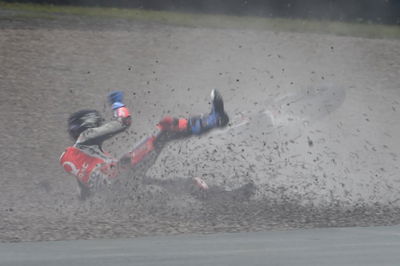MotoGP: Taming the Waterfall, top speeds

"Everything we do that enables bikes to be ridden more easily, means they are ridden faster."
Those are the words of MotoGP race director Mike Webb to describe the dilemma faced over corners such as Sachsenring's infamous Turn 11.
The fast downhill corner, nicknamed 'The Waterfall', was again the scene of numerous accidents during cold morning conditions at the recent German MotoGP.
Each year some riders ask for it to be modified as a result, yet there is not a particular 'fault' with the corner - no bumps, incorrect kerbing or inconsistency in the asphalt - and no concern over the size of the run-off area.
Instead, the main problem is that the quickest turn on the track is preceded by seven left handers, allowing the right side of the tyre to cool by the time it is needed most.
Adding to the challenge, or danger, is the negative camber as the track plummets downhill. That occurs just as riders get on the gas, further reducing load on the front wheel. Almost all of the Waterfall accidents are from losing the front.
"It's like every circuit in the world, it is the cost/benefit of what can be done," Webb said. "So the fix there, and it's a huge fix, is to change the camber of the entire corner. That is an enormous thing, but it would help a lot."
 |
| The Waterfall has been catching riders out for a long time, here is Dovizioso in 2013 (pic: Gold&Goose). |
But should you change corners to make them 'easier' for the best riders in the world, when run-off space is not an issue?
"That's one of the things that goes through my mind when we talk about changing anything," Webb replied. "For example, water gathers at the bottom of that hill, but if you change the camber so the water would drain you've got a faster corner and a faster entry.
"I've got an ongoing mission or discussion with the manufacturers about slowing the bikes down. And everything we do that enables bikes to be ridden more easily, means they are ridden faster.
"I don't want to make dangerous corners, but there is a limit to how much you can adapt the race track because it just makes it faster and then you transfer the [safety] problem to another area such as run-off size.
"This whole argument also includes the wing debate; some people say 'we need downforce' for safety, but then they'll go faster.
"It was also part of the unified electronics decision; the bikes are harder to use now because the electronics are not as good. But imagine how much faster the bikes would be with [factory] electronics.
"So making the bikes and tracks more difficult can slow things down."
One example of this is the revised final turn hairpin at Sepang, which has been given an 'awkward' negative camber to try and reduce top speeds along the following main straight.
The end result during this year's World Superbike event was a peak race top speed of 303km/h compared with 310km/h the previous year.
But back to the Sachsenring and the easiest solution to the Waterfall accidents: A back-up, super-soft front tyre.
"There was a lot of apprehension being the first time here for Michelin and with the debut of the asymmetric front - and then suddenly on Friday morning it's only 14-degrees. Remember the same happened with Bridgestone here in the cold weather. We had even more crashes," Webb explained.
"The shorter fix now that Michelin has the experience - after not being here for some years - is to be ready with a very, very soft tyre in the trailer. They had prepared the softest they thought they would ever need and on Saturday [when the temperature increased] there were no problems."
 |
| Andrea Iannone at the 2016 Italian MotoGP (pic: Gold&Goose). |
The all-time MotoGP top speed record has been broken for the past three years, culminating in a 354.9km/h (220.5mph) by Ducati's Andrea Iannone at Mugello this season.
"For sure, top speed figures sound scary and the present numbers are very high," MotoGP director of technology Corrado Cecchinelli told Crash.net. "But while I remember some big accidents at top speed, normally to do with tyres, fortunately I don't remember an accident with very bad consequences.
"That is partially to do with the dynamics of a straight-line accident [sending riders forwards rather than sideways] and because there are good track designers who make enough run-off at the end of the top speed area.
"Cornering speed and cornering run-off makes the biggest difference for rider safety and always keep in mind that motorcycling is dangerous and residual risk will never be zero. It is our target to make it as a safe as possible, and everyone is playing their part from track designers to tyre manufacturers, but it will never be safe.
"That said, a lower top speed will never be more dangerous and if making the bikes slower is the target, it is very easy to achieve by a rev limiter, or by any means that reduces engine power.
"So it's only a matter of wanting to make it happen from the manufacturers' side.
"Until then, if I was the one to decide - which I'm not - I would not introduce any changes in the regulations that will clearly make the bikes any faster.
"If the regulations stay the same I expect the bikes to get marginally faster due to aerodynamic evolution, better tyres etc... but I don't see them going 20 km/h faster than now."












